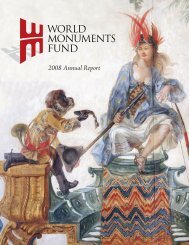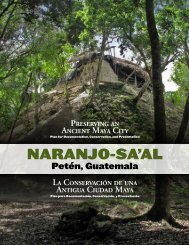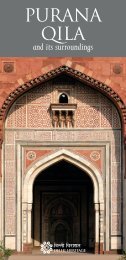Summary of the Proceedings and Papers Presented at - World ...
Summary of the Proceedings and Papers Presented at - World ...
Summary of the Proceedings and Papers Presented at - World ...
You also want an ePaper? Increase the reach of your titles
YUMPU automatically turns print PDFs into web optimized ePapers that Google loves.
A Lightweight Covering System<br />
for Protection <strong>of</strong> Archaeological Sites<br />
<strong>and</strong> Remains: Testing a Prototype for<br />
a Newly Excav<strong>at</strong>ed Area in Pompeii<br />
by Maria Rosaria Motolese<br />
The I.C.I.E. 1 Institute has been responsible for coordin<strong>at</strong>ing<br />
<strong>and</strong> conducting research activities within <strong>the</strong><br />
CORARC 2 <strong>and</strong> COVAR 3 consortia, which were set<br />
up as part <strong>of</strong> <strong>the</strong> Ministry for Universities, Scientific<br />
Research <strong>and</strong> Technology (MIUR) N<strong>at</strong>ional Program <strong>of</strong> Research<br />
<strong>and</strong> Training in Cultural <strong>and</strong> Environmental Heritage,<br />
to study methodologies <strong>and</strong> technologies for <strong>the</strong> management<br />
<strong>and</strong> use <strong>of</strong> archaeological sites. Research activities<br />
conducted by <strong>the</strong> two consortia followed <strong>the</strong> p<strong>at</strong>h set out by<br />
MIUR, producing results th<strong>at</strong> were applied experimentally in<br />
an area <strong>of</strong> new excav<strong>at</strong>ions <strong>at</strong> Pompeii <strong>and</strong> <strong>at</strong> <strong>the</strong> “Villa dei<br />
Papiri” in Herculaneum.<br />
Previous structure covering <strong>the</strong> site<br />
Methodology <strong>and</strong> project definition<br />
The CORARC consortium’s research resulted in <strong>the</strong> production<br />
<strong>and</strong> testing <strong>of</strong> a “new system <strong>of</strong> components for <strong>the</strong><br />
construction <strong>of</strong> lightweight structures for <strong>the</strong> protection <strong>of</strong><br />
archaeological sites <strong>and</strong> remains.” The MIUR technical specific<strong>at</strong>ions<br />
require th<strong>at</strong> <strong>the</strong> protective system should be:<br />
n non-intrusive, with respect to <strong>the</strong> archaeological remains<br />
it protects, as well as stable <strong>and</strong> self-st<strong>and</strong>ing.<br />
n a vers<strong>at</strong>ile <strong>and</strong> reversible system; completely removable<br />
without damage to <strong>the</strong> site, with dimensions th<strong>at</strong> can be<br />
enlarged to fit <strong>the</strong> requirements <strong>of</strong> <strong>the</strong> site using o<strong>the</strong>r<br />
components or modules<br />
n adaptable to <strong>the</strong> needs <strong>of</strong> <strong>the</strong> site, so th<strong>at</strong> it can be<br />
enlarged horizontally according to <strong>the</strong> size <strong>and</strong> position<br />
<strong>of</strong> <strong>the</strong> base pl<strong>at</strong>es, <strong>and</strong> vertically with a system <strong>of</strong><br />
variable vertical supports<br />
1 ICIE – cooper<strong>at</strong>ive institute for technological innov<strong>at</strong>ion <strong>and</strong> transfer<br />
set up in 1972 to promote, coordin<strong>at</strong>e <strong>and</strong> realize projects for applied<br />
research <strong>and</strong> technological innov<strong>at</strong>ion <strong>of</strong> products <strong>and</strong> processes,<br />
developed in cooper<strong>at</strong>ion with companies, universities <strong>and</strong> n<strong>at</strong>ional<br />
<strong>and</strong> intern<strong>at</strong>ional research centers.<br />
italiano<br />
n <strong>of</strong> a modular design so th<strong>at</strong> base pl<strong>at</strong>es can be<br />
combined: <strong>the</strong> system's basic module (distance between<br />
supports) is about 3 meters, a multiple <strong>of</strong> <strong>the</strong> average<br />
measurement in ancient structures, which makes it<br />
easier to assemble in various combin<strong>at</strong>ions to effectively<br />
cover <strong>the</strong> archaeological remains.<br />
n a system <strong>of</strong> slim modules, made with high quality<br />
m<strong>at</strong>erials: aluminum for <strong>the</strong> main structure, toughened<br />
glass for <strong>the</strong> covering, <strong>and</strong> special solutions for linking<br />
elements, such as hidden stainless steel bolts for beams<br />
<strong>and</strong> supports, <strong>and</strong> stainless steel hinges for glass panels.<br />
n equipped with walkways for visitors, <strong>and</strong> vertical<br />
closures or internal partitions, making <strong>the</strong>m even more<br />
flexible.<br />
This “Open System” provides a basic design solution for<br />
sheltering archaeological sites; it is a system th<strong>at</strong> can adapt<br />
to individual circumstances, <strong>and</strong> be modified to cre<strong>at</strong>e a<br />
structure specifically designed for <strong>the</strong> needs <strong>of</strong> a given site.<br />
The CORARC System Prototype<br />
The CORARC prototype has been designed keeping in<br />
mind <strong>the</strong> specific characteristics <strong>of</strong> <strong>the</strong> site <strong>of</strong> Pompeii: on<br />
one side, <strong>the</strong> found<strong>at</strong>ion plinths <strong>of</strong> its ballasted supports are<br />
interred without interfering with <strong>the</strong> site, <strong>and</strong> on <strong>the</strong> o<strong>the</strong>r<br />
side, <strong>the</strong>y lean on a protective surface on <strong>the</strong> existing cocciopesto.<br />
The system does not alter <strong>the</strong> effect <strong>of</strong> sunlight<br />
on <strong>the</strong> site <strong>and</strong> <strong>the</strong> archaeological remains, because all its<br />
surfaces (ro<strong>of</strong>, external <strong>and</strong> internal walls) are made with<br />
transparent glass. An aluminium gangway allows visitors to<br />
view <strong>the</strong> mouldings from above; <strong>the</strong> gangway is positioned<br />
between an external vertical opening <strong>and</strong> an internal partition,<br />
which are made <strong>of</strong> structural glass to ensure <strong>the</strong> safety<br />
<strong>of</strong> both visitors <strong>and</strong> archaeology.<br />
Conclusions<br />
The realized prototype is an experimental example <strong>of</strong><br />
adapting <strong>the</strong> CORARC “open system” to protect <strong>the</strong> mouldings<br />
<strong>of</strong> a group <strong>of</strong> fugitives near Stabianus house (Nuovi<br />
Scavi di Pompei), which were left on <strong>the</strong>ir original site for<br />
<strong>the</strong> first time by <strong>the</strong> Soprintendenza Archeologica di Pompei.<br />
The prototype’s innov<strong>at</strong>ive characteristics allowed it to<br />
be modified to properly shelter <strong>the</strong> site, <strong>and</strong> its protective<br />
fe<strong>at</strong>ures made it possible to open <strong>the</strong> site to visitors.<br />
2 CORARC – consortium firms ISMES & MUCAFER. Coordin<strong>at</strong>ion: ICIE<br />
& CREA. Scientific responsibility: Soprintendenza Archeologica di<br />
Pompei.<br />
3 Consortium for Archaeological Evalu<strong>at</strong>ion.
















